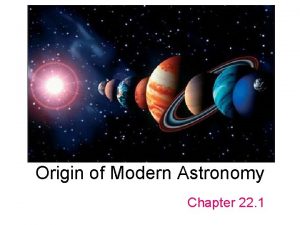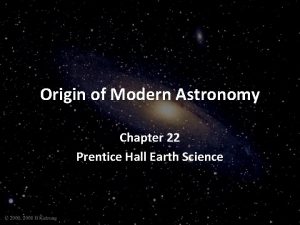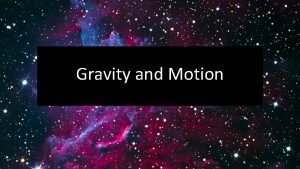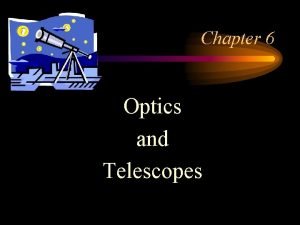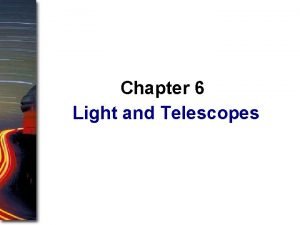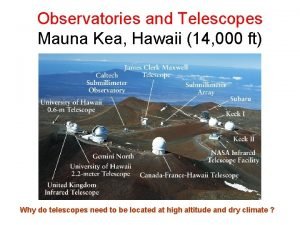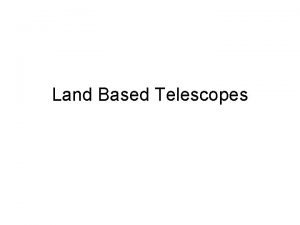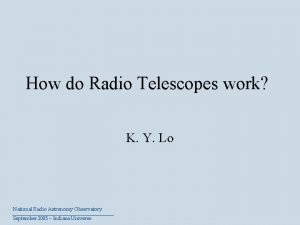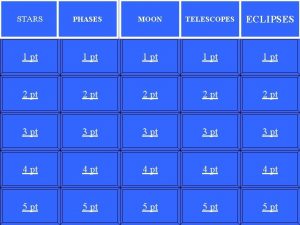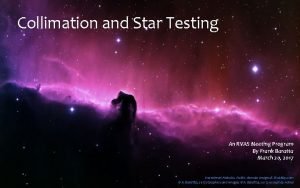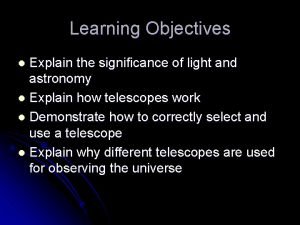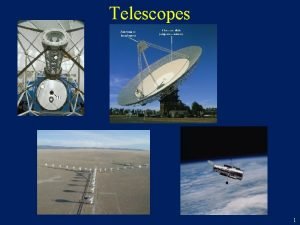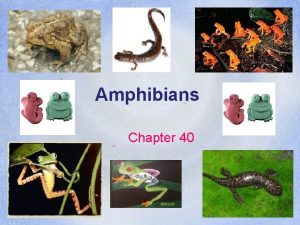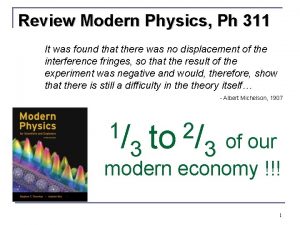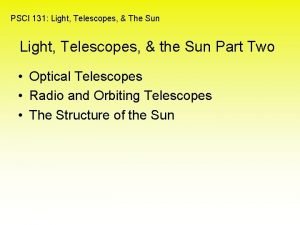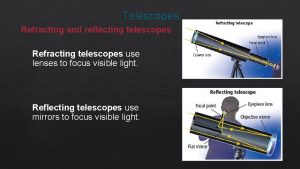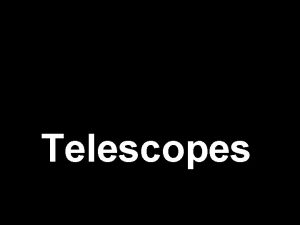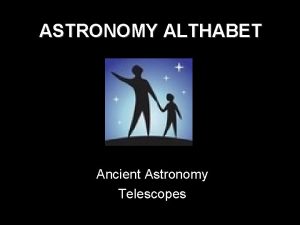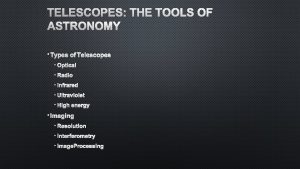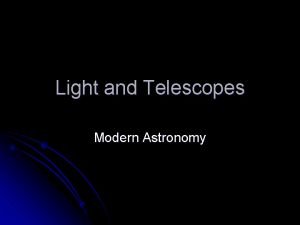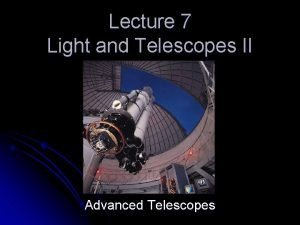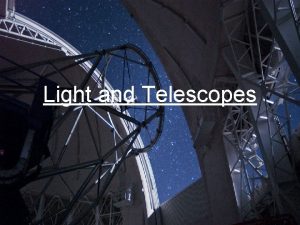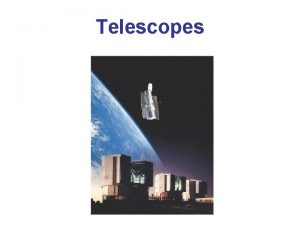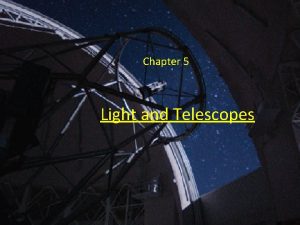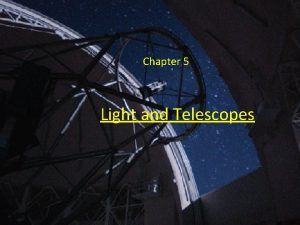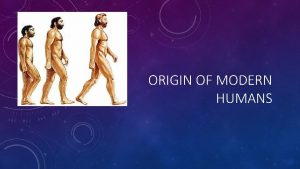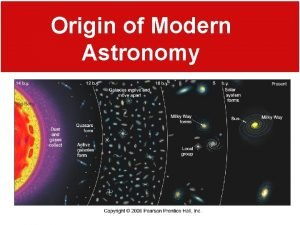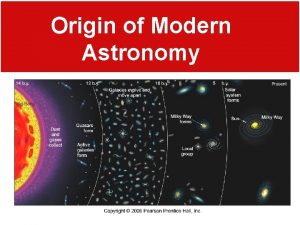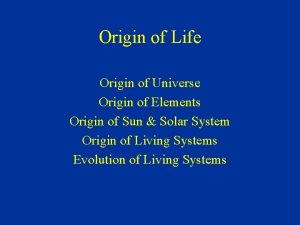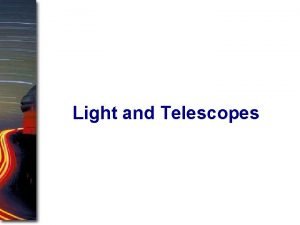Astronomy Review Origin of Modern Astronomy Light Telescopes






























- Slides: 30

Astronomy Review Origin of Modern Astronomy Light, Telescopes, and the Sun Beyond Our Solar System

The Greeks • Geocentric • Universe was made of Earth, 7 ‘planeti’, stars • Important discoveries • Earth is spherical (Aristotle) • Earth casts a curved shadow when it eclipses the Moon. • Earth’s circumference (Eratosthenes) • Measured shadows in two cities separated by known distance on the same day • Heliocentric solar system (Aristarchus) • Determined the distances from Earth to Moon and Sun • People didn’t believe, no stellar parallax

Ptolemaic System • Geocentric model – 1 st organized explanation of celestial motion • Planets move along small circles while orbiting Earth on large circles • Retrograde motion • Illusion that a planet moves backwards • Mars sometimes looks like it’s moving backwards because Earth is orbiting faster than Mars

Renaissance Timeline Kepler 1571 1630 1400 Copernicus 1473 1543 1564 1450 First printing press 1492 1546 Galileo 1642 1601 Brahe 1642 1776 1727 Newton

Renaissance Bigwigs • Copernicus - Earth is a planet and orbits the Sun • Heliocentrism • Used circles as orbital path instead of ellipses so couldn’t predict future locations of planets • Brahe - didn’t observe stellar parallax • Geocentrism • didn’t observe stellar parallax that would happen if Earth revolved around the Sun • Kepler – first mathematical model of celestial motion • Heliocentrism • Developed laws of planetary motion • The orbital path of the each planet is an ellipse • Planets move faster when closest to Sun and slower when they are farther away • Distant planets orbit the Sun at slower average speeds than planets that are closer to the Sun

Renaissance Bigwigs • Galileo – first astronomer to use telescope • • Heliocentrism Observed four of Jupiter’s moons – Earth isn’t only center of motion Venus has phases, like the Moon (proof of heliocentrism) Observed sunspots and determined Sun rotates about once a month • Newton – explained why planets move in orbits (gravity + inertia) • Heliocentrism • Inertia (1 st Law of Motion): an object in motion continues in motion with same speed and in same directions unless acted upon by external force • Universal gravitation: all objects in universe exert an attractional force on each other • Force increases with mass and decreases with distance

Earth Motions • Earth rotates on its axis • Earth revolves around the Sun in elliptical orbit • Perihelion – closest to Sun • Aphelion – farthest from Sun

Earth-Moon System • The Moon • • Rotates around axis every 27. 5 days Revolves around Earth every 27. 5 days Same side always faces Earth Phases • Result of the motion of the Moon and sunlight that is reflected from the surface

Eclipses • Lunar eclipse • Moon moves within Earth’s shadow • Only during full Moon • Solar eclipse • Moon passes directly between Earth and Sun • Only during new Moon

Light, Telescopes, and the Sun

EM Spectrum

The Three Spectra

Light tells us about… • Composition • Elements emit and absorb a unique set of wavelengths • Temperature • All objects radiate a continuous thermal spectrum • Hotter objects emit more light per unit area and emit more of their light at shorter wavelengths (higher energy) • Motion of distant objects (Doppler effect) • Apparent shift in wavelength relative to a stationary observer • Star moving away from Earth = RED shift • Star approaching Earth = BLUE shift • Large shifts either way indicate high velocities

Optical Telescopes • Refracting • Uses a lens to bend the light to produce and image • Inexpensive, but have chromatic aberration • Reflecting • Uses concave mirror to gather the light • Nearly all large telescopes are this type, higher magnification • Expensive, no chromatic aberration

Radio and Space-based telescopes • Radio • Gather radio waves from space using large dishes • Advantages and disadvantages? • Orbital • Detect all forms of light – why is this important? • Now more than 100 space-based telescopes/observatories

The Sun • Composition and size • • Gaseous (90% Hydrogen, 10% Helium, others <1%) Density: slightly greater than water (1/4 of Earth’s) 100 times Earth’s diameter 1. 25 million times Earth’s volume

The exterior • Photosphere – “sphere of light” • Surface of Sun – 6000 K • Layer of incandescent gas, radiates observable sunlight • Grainy texture made of granules produced by convection • Chromosphere – “color sphere” • Lowermost atmosphere, seen as red ring around Sun • Layer of incandescent gases, radiates most of Sun’s UV light • Corona – “crown” • Outermost atmosphere • Ionized gases, temp at top is over 1 million K • Source of solar wind

The interior • Three distinct layers • Core: Region where Sun’s energy is radiated • Radiation zone: Above the core, dense zone where radiation is absorbed and re-emitted • Convection zone: Between radiation zone and photoshere, convection transports energy outward • Solar energy • Nuclear fusion in core • Four hydrogen nuclei are converted into a helium nuclei • 600 million tons of hydrogen is consumed each second • Sun has enough fuel to last another five billion years

Irregular solar activity • Sunspots • Dark spots on surface • 11 year cycle, governed by magnetic field • Prominences • Huge arching cloudlike structures that extend into corona • Solar flares • Explosive events, release lots of energy (UV and X-ray) • CMEs • Eject particles that create magnetic storms • Cause auroras

Beyond the solar system

Classifying stars • Brightness (luminosity or magnitude) • Factors: size, temperature, distance from Earth • Apparent magnitude • Brightness as it appears from Earth • 1 st magnitude star about 100 times brighter than 6 th magnitude star • Zero and negative magnitudes: brighter than 1 st magnitude (Sun = -26. 7) • Absolute magnitude • “True” brightness • Determine luminosity a star would have if it were located a standard distance, 32. 6 light-years • Most stars have absolute magnitude between -10 (very bright) and 20 (very dim)

Color and temperature • Colors are the result of temperature • Very hot (above 30, 000 K) = blue b/c short-wavelength light • Cooler (less than 3000 K) = red b/c longer-wavelength light • Sun is 5000 -6000 K, so it appears yellow-white

Hertzsprung-Russell (H-R) diagram • Plots stars according to absolute magnitudes and temperature • 90% of stars are main sequence stars • Exceptions • Red giants • Supergiants • White dwarfs

Two Key Forces Within Stars • Gravity • Promotes contraction • Gas pressure • Outward movement of gas and energy from star’s core • Promotes expansion • Stellar evolution is a balance between them

• Stellar evolution • • • Molecular cloud Protostar Main-sequence star Red giant Burn out and death

Stellar remnants • Type depends mainly on star’s mass during main-sequence • White dwarf • Earth-size with masses similar to Sun’s • composed of super compressed gas • smallest are most massive • Neutron star • form as result of supernova event (electrons combine with protons to form neutrons) • Black holes • Densest objects known • Gravity is so strong that even light can’t escape

Galaxies • Collections of interstellar matter, stars, and stellar remnants bound together by gravity • Types • Spiral: halo, central bulge, and galactic disk • Barred spiral galaxy • Elliptical • Have a central bulge and halo, but no galactic disk • Largest and smallest known galaxies • Irregular • No symmetry • Former spiral or elliptical galaxies • Clusters: groups of galaxies

The Universe • Big Bang • Cataclysmic explosion about 13. 8 billion years ago • First stars formed 200 million years after Big Bang, composed of hydrogen and helium • These were massive stars, died violently, incorporated into future stars • Expanding universe • Most galaxies moving away from Milky Way and most distant galaxies are moving away at fastest rate • How do we know?

Fate of Universe • Two possibilities • “Big Chill”: Stars will burn out, and galaxies will become more widely separated in an endless cold, dark universe • “Big Crunch”: Outward expansion will stop and gravitational; contraction will follow • Ultimately depends on density of universe • Greater than critical density = collapse • Less than critical density = expansion

Final Exam • Wednesday, May 2 at 9: 50 -11: 35 • PLEASE BE ON TIME! • Format: • Multiple choice • True/false • Bring: • 3 inch x 5 inch notecard • Both sides • Handwritten
 Chapter 22 origin of modern astronomy
Chapter 22 origin of modern astronomy Johannes kepler
Johannes kepler Modern telescopes make it possible for astronomers
Modern telescopes make it possible for astronomers All modern large optical telescopes are refractors.
All modern large optical telescopes are refractors. Guidepost of light
Guidepost of light Learning astronomy by doing astronomy
Learning astronomy by doing astronomy Learning astronomy by doing astronomy answers
Learning astronomy by doing astronomy answers Learning astronomy by doing astronomy activity 1 answers
Learning astronomy by doing astronomy activity 1 answers Light light light chapter 23
Light light light chapter 23 Into the light chapter 22
Into the light chapter 22 Chapter 22
Chapter 22 A building that contains one or more telescopes
A building that contains one or more telescopes Chromatic aberration affects reflector telescopes.
Chromatic aberration affects reflector telescopes. Light bucket telescope
Light bucket telescope Computer controlled telescopes
Computer controlled telescopes How do radio telescopes work
How do radio telescopes work New moon telescopes
New moon telescopes Star test collimation
Star test collimation Timeline of telescopes
Timeline of telescopes Significance of light
Significance of light How do telescopes work
How do telescopes work Origin and evolution of amphibia
Origin and evolution of amphibia Effects of light on smart and modern materials
Effects of light on smart and modern materials University of delaware virtual microscope
University of delaware virtual microscope 1886 modern compound light microscope
1886 modern compound light microscope Review of modern physics
Review of modern physics Chapter 9 review stoichiometry
Chapter 9 review stoichiometry Trinitrogen monosulfide formula
Trinitrogen monosulfide formula Chapter 14 review acids and bases
Chapter 14 review acids and bases Modern chemistry chapter 13
Modern chemistry chapter 13 Chapter 12 review solutions section 3
Chapter 12 review solutions section 3
